Introduction
The new and rapidly growth of ICT has changed the face of the world. ICT has become the main influential determinant in economic, social, and human development (Dertouzos, 1997), and is being considered as the umbrella for the communication and networking devices and software with applications (Jain, 2006). The Hashemite Kingdom of Jordan (HKJ) is one of the highly developed Arab countries in the Middle East. The King and the Government have sponsored many initiatives to encourage the diffusion of technologies in the country that not only possessing the geographical advantage, but also often seeking to develop technological workforces to increase the standard of living and economic productivity (Al-Jaghoub and Westrup, 2003). Jordan focuses on the higher education sector and universities significantly in regards to the development of human resources in the country.
The adoption and diffusion of educational technologies that leverage ICT and the Internet has provided an unprecedented opportunity for improving higher education around the world (Davis and Wong, 2007). Therefore, educational technologies must become more popular among developing nations which seek economic improvement (Khasawneh et al., 2011). In fact, the educational technology is becoming more universal at an increasing rate as most firms recognize the needs to prepare the ICT professionals for the global environment (Margavio, 2005).
In the matter of fact, the higher education sector in Jordan plays a critical role in the growth the national economy because the individuals have strong needs and interests in education to develop their knowledge and skills to become competitive and knowledge workers in the global markets. Unfortunately, until now there is a lack of ICT usage among the universities’ academic staff in Jordanian higher educational institutions (Al-Mobaideen, 2009). Apart from that, the adoption and usage of ICT in universities in teaching and learning process are still limited among the academicians (Patnaik, 2001), in which they have lack knowledge, skills, motivation, and interests in using ICT in facilitating their works (Jawarneh et al., 2007; Qudais et al., 2010). From the perspective of ICT usage, this study makes an attempt in bridging the digital divide between developed and developing countries in the use of ICT in the education and learning process through Jordanian higher education institutions. The optimum using of ICT by academic staff in the universities will develop the quality of alumnus and improve the teaching and learning process in creating new generation capable and competitive in the global market.
Literature Review
Midgley and Dowling (1978) defined innovativeness as the time to which an individual is receptive to new ideas and product and makes adoption decisions independently of the communicated experience of others. In relation, the diffusion of innovation is a communication process they define innovativeness as a personality trait they call ‘innate innovativeness’ operating at the most abstract, global level of conceptualization to influence a variety of domain-specific behaviors, including the relative early purchase of new products (Midgley and Dowling, 1978).
Also, they proposed an intermediary level of product-category specific innovativeness which mediates the effects of innate innovativeness along with a variety of inter-individual difference variables and situational factors on actual innovation adoption (Midgley and Dowling, 1978). This definition opened up a new vista for studying innovative behavior as this view of innovativeness is postulated to all product classes. This led to propose a new model to study innovativeness as shown in Figure 1 below.
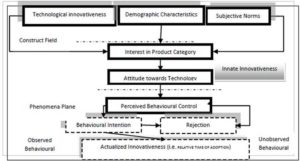
Fig 1. Research Model
The above model defines the innovativeness construct in a more comprehensible manner, suggests categories of variables that could be used to operationalize the model and provides examples of variables in each category. The model integrates the innovator (academician), the product (ICT), and the situation specificity as determinants of innovative behavior. As shown, the model is divided into three parts: (i) the construct field, (ii) phenomena plane, and (iii) (un)observed behavior. The construct field comprises into (a) demographic variables, (b) technological innovativeness, and (c) subjective norms. The phenomenon plane starts with an interest in the product category which is bolstered or dampened by intervening variables pertaining to product or technology characteristics. All these lead to the next phenomenon by intervening previewed behavior control factors that affected in the behavioral intention (BI).
This proposed model brings together many of the factors of greatest relevance identified in previous literature such as attitude towards technology (ATT), subjective norms (SN), and perceived behavioral control (PBC). The model shows the importance and recognition of external situational and environment factors commonly acknowledged in the literature as influencing ICT adoption, and which are missing from the general diffusion of innovation developed for innovations in general. The proposed model presents many factors which are considered impact upon the individual’s adoption of ICT in addition to demographic variables.
The purpose of this study is to identify the factors that affect on the adoption of ICT at the institutional higher education in Jordan. The initial model is framed within the Diffusion of Innovation (DOI) (Rogers, 1995), and enhanced by others such as Theory of Planned Behavior (TPB) (Ajzen, 1991), and the Decomposed Theory of Planned Behavior (DTPB) (Taylor and Todd, 1995a). The model, and its corresponding hypotheses, incorporates the constructs that are considered to be most relevant to adoption in Jordan. These include the following factors:
- Demographic variables such as gender, age, higher education degree, place of obtaining higher education degree, major, and experience.
- ATT such as Rogers’ attributes; relative advantage (RA), compatibility (Compt), complexity (Compx), trialability (Trial), and observability (Observ) (Rogers, 1995).
- SN such as word of mouth (WoM), and mass media channels (MMC) (Ajzen, 1991).
- PBC such as self efficacy (SE), technology facilitating conditions (TFC), resource facilitating condition (RFC), and government facilitating condition (GFC) (Taylor and Todd, 1995a, 1995b).
Factor Analysis
A wide series of factor analysis in the shape of Principle Component Analysis (PCA) is utilized to test for both the convergent and discriminate validity of the measurements. Factor analysis is an interdependent technique and the primary purpose of using it, is to define the underlying structure among the variables in the analysis (Zikmund, 2003; Hair et al., 2006). PCA and principal factors are the most commonly used (Tabachnick and Fidell, 2007). The aims that this study seeks to achieve from the factor analysis technique are discussed in the subsequent paragraphs.
The first aim is to analyze the scale items of each construct and verify their discriminate validity. Discriminate validity concerns with the ability of a measurement item to differentiate between the objects being measured (Davis, 1989). Malhotra (2004) puts it in another way, saying that discriminate validity aimed to identify new uncorrelated variables to be used in subsequent multivariate analyses such as regression.
The second aim is to reduce the large number of interrelated variables to a small number of underlying factors that ensures the construct validity. It addresses the question of what construct or characteristic the scale is, in fact, measuring (Malhotra, 2004).
The third aim is to explain the interrelations between the constructs and the variables measuring them. It is concerned with whether constructs’ items form distinct constructs (Davis, 1989). The fourth aim is to identify a smaller set of salient variables for use in subsequent multivariate analysis (Malhotra, 2004). Lastly, factor analysis may be utilized to meet the statistical assumptions of various models (Zikmund, 2003).
Factors Analysis for Criterion Variable BI
The four items of the BI construct assumed were subjected to PCA, Varimax with Kaiser Normalization as rotation method shown in Table 1, to determine how many dimensions those items which measure BI will converge along.
Table 1: PCA Result Component Matrix and Factor Loading: BI
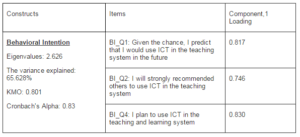
Consequently, the result of factor analysis in this construct revealed the following:
- The presence of one component with eigenvalues of 2.63 exceeding the recommended value of one.
- The factor analysis provided a solution in one component which explained 65.6% of the variance.
- An assessment of the Kaiser-Meyer-Olkin (KMO) value was of 0.801, which shows that the sampling adequacy for factor analysis was appropriate and the Barlett’s Test of Sphericity reached statistical significance, supporting the factorability of the correlation matrix.
The interpretation of this component was consistent with previous research on the BI scale. In addition, the result of this analysis supports the use of selected items as a scale of BI as suggested by the scale (Mathieson, 1991; Venkatesh and Davis, 2000; Gardner and Amoroso, 2004; Shih and Fang, 2004).
Direct Psychosocial Determinants of BI
In this study, exploratory factor analysis (EFA) was employed to identify the factors underlying direct predictors (ATT, SN_WoM, MMC, and PBC). In this case, the factor extraction method of Principal-Axis Factoring Analysis (PFA) was selected because it is useful in determining the number of factors necessary to represent the data (Coakes and Steed, 2003).
Factor analysis revealed the presence of four components with eigenvalues exceeding one. In addition, the required 4 factors were retained on the measurement for the three direct factors conceptually and theoretically assumed to be the direct predictors of BI. The interpretation of the four components was consistent with the theory of TPB on the direct scale of BI (Fishbein and Ajzen, 1975; Ajzen, 1991; Taylor and Todd, 1995a; Taylor and Todd, 1995b). In conjunction, Table 2 shows the items used to measure BI and their loading onto four different components as follows;
Table 2: PFA Result: Factors Underlying Direct Attributes of BI
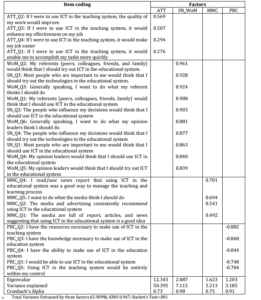
The set of 23 items comprising four constructs (ATT, SN_WoM, MMC, and PBC) were subjected to factor analysis and the solution was rotated using rotational method with the Oblimin with Kaiser Normalization approach. The result of the analysis indicates that:
- Respondents involved in the study sample are able to distinguish the variation among the four of BI functions (direct determinants) or predictors of BI whereby this findings in agreement with the DOI, TPB, and the DTPB of the direct predictors.
- The assessment of direct determinants of BI construct, according to respondents, seemed to be through four predictors; (ATT, SN_WoM, MMC, and PBC).
- An assessment of the KMO value was of 0.947 which shows that the sampling adequacy for factor analysis was appropriate and the Barlett’s Test of Sphericity reached statistical significance, supporting the factorability of the correlation matrix.
Factor Analysis of Salient Variables
The adoption’s model that combines the three independent variables (ATT, SN, and PBC) to explain the intention to use innovation performs well by exceeding the 40% in the explaining the intention that was achieved by several other theoretical models in the fields of information systems. Evidence of efficacy was drawn from meta-analytic review of 185 independent studies, in which they demonstrated that TPB has accounted for 27% to 39% of the variance in BI (Armitage and Conner, 2001).
This study uses three adoption theories in proposing a new model related to the area of the study. The theories are DOI (Rogers, 1995), TPB (Ajzen, 1991), and DTPB (Taylor and Todd, 1995a, 1995b).
Contrast with expectations, the results of SN predictor showed difference with TPB (Ajzen, 1991). The findings of PFA shown in Table 3 reveal that only two factors out of three predetermined variables related to the SN of TPB were statistically extracted by the study. Results of the PFA demonstrated that there are two normative beliefs components were found related to the BI which are subjective norms with the personal channels (SN_WoM) and the MMC.
Table 3: PFA Result: Type of Interaction’s Norms

Rogers’ five attributes explain the educational technology characteristics which affect academic staffs’ attitude toward the use of these technologies (Rogers, 1995). As study expects, the results of the PFA shown in Table 4 reveal that all the factors which are defined in DOI appear as separated factors. The factors are RA, Comp, Compx, Trial), and Observ.
Table 4: PFA Result: ICT Attributes
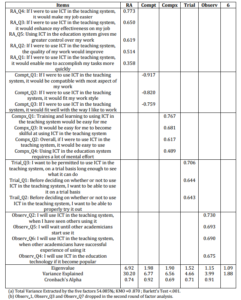
The last predictor of the proposed model is control belief, in which the results of this factor are consistent with the DTPB (Taylor and Todd, 1995a, 1995b), decomposed into two dimensions; SE and facilitating conditions (FC). The FC construct was broken down into three other dimensions, which include TFC, RFC, and GFC. As expectation, the results of the PFA shown in Table 5 reveal all the factors that defined in DTPB appear as separated factors.
Table 5: PFA Result: Control Belief
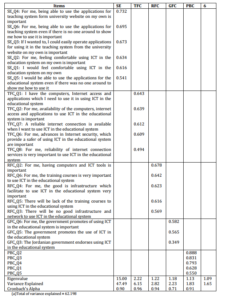
This study is motivated by the need to inform researchers and practitioners about what are the factors that affect academic staff to adopt or reject ICT in Jordanian institutional and encourage faster and more efficient adoption. This is a theory building investigation to explore the factors that are likely to influence the use of ICT among staff in the Jordanian higher education institutions. However, there is no known study that has empirically investigated such factors. Little attention has been paid in the literature to the adoption of ICT in the context of developing countries in general. As the objective of the present study is to consider academic staffs’ behavior pertaining to the adoption of ICT, we carefully chose the variables that the literature has shown to be important in explaining the adoption of ICT, which are amenable to statistical analysis.
Conclusion
The study is considered novel in the developing countries, Jordan and the Arab world in particular, which share the same culture, language and religion. It makes a significant contribution to theory and academic understanding of the adoption in areas of IS, and specifically ICT usage in higher education institutions, Jordanian context. As a summary, understanding the behavioral aspect of adoption is important to both researchers and industry players. The findings of the current research contribute to theoretical modelling by modifying the IS adoption theories in relation to a new application area that may give new insights into the theory. It is also proposed that this study improves a successful adoption of the particular services (ICT) that are supported by new technologies by deepening the knowledge about factors which inhibit or facilitate the adoption among the developing nation and the Arab countries in particular, as these countries share similar culture, religion, and speak the same language. Eventually, the proposed research model will be the authority for all universities to encourage the adoption and utilization of ICT in the educational and learning process in Jordan and all Arab countries.
References
Ajzen, I. (1991). “The Theory of Planned Behavior,” Organizational behavior and human decision processes, 50(2), 179-211.
Publisher – Google Scholar
Al-Jaghoub, S. & Westrup, C. (2003). “Jordan and ICT-Led Development: Towards a Competition State,” Information Technology and People, 16(1), 93-110.
Publisher – Google Scholar
Al-Mobaideen, H. O. (2009). “ICT Diffusion in Jordanian Universities,” European and Mediterranean Conference on Information Systems 2009 (EMCIS2009) July 13-14 2009, Crowne Plaza Hotel, Izmir.1-21.
Publisher – Google Scholar
Armitage, C. J. & Conner, M. (2001). “Efficacy of the Theory of Planned Behaviour: A Meta Analytic Review,” British Journal of Social Psychology, 40(4), 471-499.
Publisher – Google Scholar – British Library Direct
Coakes, S. J. & Steed, L. G. (2003). SPSS: Analysis without Anguish: Version 11.0 for Windows, John Wiley and Sons Inc. Australia.
Publisher
Davis, F. D. (1989). “Perceived Usefulness, Perceived Ease of Use, and User Acceptance of Information Technology,”MIS quarterly, 13(3), 319-340.
Publisher – Google Scholar
Davis, R. & Wong, D. (2007). “Conceptualizing and Measuring the Optimal Experience of the eLearning Environment,”Decision Sciences Journal of Innovative Education, 5(1), 97-126.
Publisher – Google Scholar – British Library Direct
Dertouzos, M. L. (1997). What Will Be: How the New World of Information Will Change Our Lives, San Francisco: Harper Collins.
Publisher – Google Scholar
Fishbein, M. & Ajzen, I. (1975). ‘Belief, Attitude, Intention and Behavior: An Introduction to Theory and Research,’ USA:Addison-Wesley Reading, MA.
Google Scholar
Gardner, C. & Amoroso, D. (2004). Development of an Instrument to Measure the Acceptance of Internet Technology by Consumers,” Paper presented at the System Sciences, 2004. Proceedings of the 37th Annual Hawaii International Conference, 1-10.
Publisher – Google Scholar – British Library Direct
Hair, J., Black, W., Babin, B., Anderson, R. & Tatham, R. (2006). ‘Multivariate Data Analysis (6 ed.’: Upper Saddle River, NJ: Pearson Education Inc.
Jain, P. (2006). “Empowering African‘s Development Using ICT in a Knowledge Management Approach,” The Electronic Library, 24(1): 51-67.
Publisher – Google Scholar – British Library Direct
Jawarneh, T. Y., El-Hersh, A. H. & Khazaleh, T. M. (2007). “Vocational Education Teachers’ Adoption of Information and Communications Technology (ICT) in the Jordanian Secondary Vocational Schools,” Umm Al-Qura University. Journal of Educational and Social Sciences and Humanities, 19(2), 11-56.
Publisher – Google Scholar
Khasawneh, A., Khasawneh, M., Bsoul, M., Idwan, S. & Turan, A. H. (2011). ‘Models for Using Internet Technology to Support Flexible E-Learning,’ Int. J. Management in Education. [Accepted].
Malhotra, N. (2004). ‘Marketing Research: An Applied Orientation (4 ed.),’ Upper Saddle River, New Jersey, USA: Pearson Prentice-Hall.
Margavio, T., Hignite, M., Moses, D. & Margavio, G. W. (2005). “Multicultural Effectiveness Assessment of Students in IS Courses,” Journal of Information Systems Education, 16(4), 421.
Publisher – Google Scholar – British Library Direct
Mathieson, K. (1991). “Predicting User Intentions: Comparing the Technology Acceptance Model with the Theory of Planned Behavior,” Information systems research, 2(3), 173-191.
Publisher – Google Scholar
Midgley, D. F. & Dowling, G. R. (1978). “Innovativeness: The Concept and its Measurement,” Journal of Consumer Research, 4(4), 229.
Publisher – Google Scholar
Patnaik, J. (2001). Higher Education in Information Age (1 ed.),’ Authors press.
Qudais, M. A., Al-Adhaileh, M. & Al-Omari, A. (2010). “Senior Faculty Members’ Attitudes in Jordanian Universities towards Using Information and Communication Technology,” International Arab Journal of e-Technology, 1(4), 135-141.
Publisher – Google Scholar
Rogers, E. M. (1995). Diffusion of innovations (4 ed.), New York: Free Press.
Publisher – Google Scholar
Shih, Y.- Y. & Fang, K. (2004). “The Use of a Decomposed Theory of Planned Behavior to Study Internet Banking In Taiwan,” Internet Research, 14(3) 213-223.
Publisher – Google Scholar – British Library Direct
Tabachnick, B. G. & Fidell, L. S. (2007). Using Multivariate Statistics, New York: Allyn and Rose.
Publisher – Google Scholar
Taylor, S. & Todd, P. A. (1995a). “Understanding Information Technology Usage: A Test of Competing Models,”Information systems research, 6(2), 144-176.
Publisher – Google Scholar – British Library Direct
Taylor, S. & Todd, P. A. (1995b). “Decomposition and Crossover Effects in the Theory of Planned Behavior: A Study of Consumer Adoption Intentions,” International Journal of Research in Marketing, 12(2), 137-155.
Publisher – Google Scholar
Venkatesh, V. & Davis, F. D. (2000). “A Theoretical Extension of the Technology Acceptance Model: Four Longitudinal Field Studies,” Management science, 46(2) 186-204.
Publisher – Google Scholar – British Library Direct
Zikmund, W. G. (2003). ‘Business Research Methods Cincinnati, OH: Thomson/South-Western: ISBN 0-03-025817-0 10.








